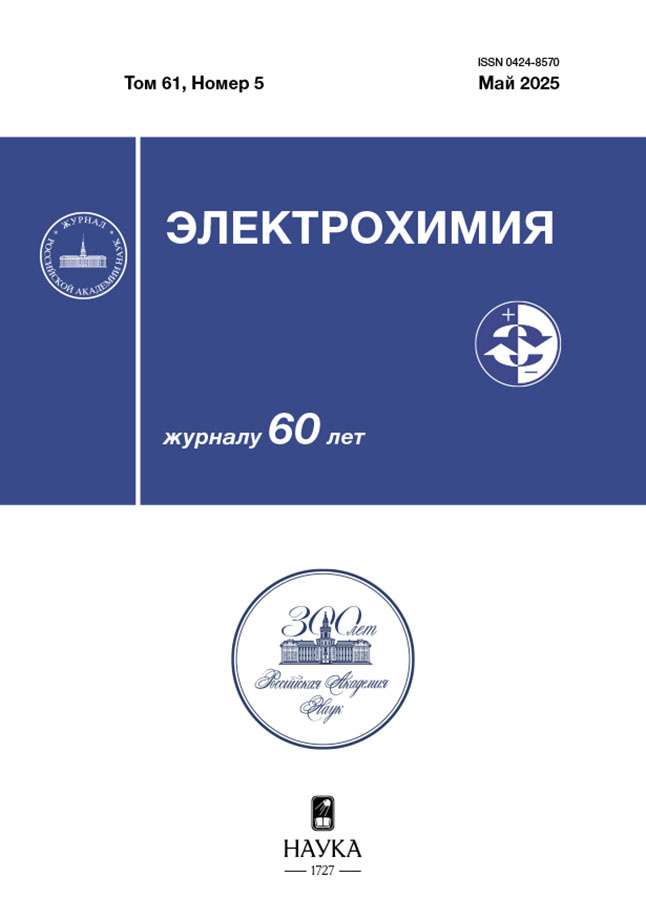Том 60, № 11 (2024): Спецвыпуск “Электрохимия-2023”, часть 2
Статьи участников Всероссийской конференции “Электрохимия-2023” (Москва, 23–26 октября 2023 года)
Оксиды меди на латунях различного фазового состава: анодное формирование и фотоэлектрокаталитическая активность
Аннотация
Оксиды меди в сочетании с другими материалами, например оксидом цинка, рассматриваются в качестве перспективных материалов для фотокаталитических процессов окисления органических примесей или фотоэлектрохимического разложения воды. Одним из способов одностадийного получения оксидных структур сложного состава является анодное окисление сплавов. Оценка фотокаталитической или фотоэлектрохимической активности полученных материалов возможна по фотоэлектрохимическим параметрам – величине фототока или фотопотенциала, генерируемых при освещении. Цель работы – определить эффективность применения оксидов Cu(I), анодно сформированных в щелочном растворе на сплавах системы Cu-Zn с концентрацией цинка от 34 до 50 ат. %, в процессе фотоэлектрохимического разложения воды. Элементный состав сплавов определен при помощи энергодисперсионного микроанализа. С ростом концентрации цинка в исследуемом диапазоне концентраций фазовый состав меняется от á- до β-фазы, что подтверждено результатами рентгеновской дифрактометрии. Изменение состава и структуры сплава находит отражение и в фотоэлектрохимических параметрах анодно сформированных на нем оксидных пленок. Наиболее перспективным материалом для фотоэлектрокаталитических превращений является оксидная пленка, анодно сформированная в 0.1 M KOH на сплаве с концентрацией цинка 50 ат. % и структурой β-фазы. При сравнительно невысокой концентрации дефектов в ней регистрируются наибольшие значения фототока при довольно высоком значении квантовой эффективности.
 747-758
747-758


Электрохимия азура с, адсорбированного на стеклоуглероде и печатном графитовом электроде из релина и фосфатного буферного раствора
Аннотация
Изучена электрохимическая активность фенотиазинового красителя Азура С, адсорбированного путем однократного циклирования потенциала из фосфатного буферного раствора и глубокого эвтектического растворителя релина на стеклоуглеродном и печатном графитовом электродах. Установлена возможность получения устойчивого вольтамперометрического сигнала красителя, сохраняющегося при последующем многократном сканировании потенциала. При проведении адсорбции Азура С из фосфатного буферного раствора образуется полислойное покрытие, в пределах которого электронный обмен формально соответствует диффузионно-сорбционному контролю лимитирующей стадии. Супернернстовский наклон рН-зависимости равновесного потенциала адсорбированного Азура С указывает на значительный вклад протонирования различных форм адсорбированного красителя и многостадийный характер процесса. При адсорбции Азура С из релина морфология вольтамперограмм меняется незначительно. Меньшая эффективность адсорбции выражается в снижении токов пика красителя и сорбционном контроле лимитирующей стадии. Различия в поведении Азура С, адсорбированного из фосфатного буферного раствора и релина, могут быть связаны с изменением степени агломерации красителя и его гидратации. Модифицированные Азуром С электроды показали способность к электростатической аккумуляции нативной и термически денатурированной ДНК, подавляющей редокс-пики Азура С на вольтамперограммах. Полученные данные могут найти применение при последующей разработке способов электрополимеризации фенотиазиновых красителей и создании электрохимических сенсоров и биосенсоров, основанных на количественной оценке редокс-активности красителей на электроде.
 759-769
759-769


Строение электрохимической границы раздела механически обновляемого графитового электрода с водными растворами поверхностно-неактивного электролита
Аннотация
С использованием методики электрохимических измерений на электродах с механически обновляемой поверхностью исследовано поведение графитового электрода в водных растворах поверхностно-неактивных электролитов. Установлена область потенциалов, в которой данный электрод ведет себя как идеально-поляризуемый. Измеренные в этом интервале потенциалов емкостные кривые имеют характерные особенности: при потенциалах, отвечающих положительным зарядам поверхности (σ > 0), величины емкости двойного электрического слоя графитового электрода примерно в 1.5–2 раза ниже аналогичных величин, наблюдаемых на типичных ртутеподобных металлах; в то же время при смещении потенциала в область, отвечающую отрицательным зарядам поверхности (σ < 0), имеет место тенденция сближения (практического слияния) указанных выше величин. Анализ полученных данных показал, что характерные особенности емкостных кривых на графитовом электроде связаны с полупроводниковыми свойствами материала этого электрода. Предложен и обоснован новый подход к модельному описанию экспериментальных данных, который позволил оценить такие важные с точки зрения полупроводниковых свойств параметры материала исследованного электрода, как потенциал плоских зон и концентрация носителей заряда в зоне проводимости.
 770-782
770-782


Рекомбинация носителей заряда в аморфных органических полупроводниках
Аннотация
Рассмотрена бимолекулярная рекомбинация носителей заряда в аморфных органических полупроводниках. Общей особенностью этих материалов является пространственная корреляция случайного энергетического ландшафта, в котором осуществляется прыжковый транспорт носителей заряда. Проведен расчет константы скорости рекомбинации, в том числе для случая локально упорядоченных материалов. Оказывается, что именно пространственная корреляция является причиной нарушения соотношения Ланжевена между подвижностями носителей заряда и константой скорости рекомбинации. Для разных источников энергетического беспорядка истинная константа скорости может быть как меньше, так и больше соответствующего ланжевеновского значения. Указаны перспективные классы органических полупроводников, константа скорости рекомбинации в которых может превышать ланжевеновское значение, что ведет к потенциальному увеличению эффективности генерации света в органических светодиодах. Органические полупроводники с малой величиной константы рекомбинации перспективны для использования в солнечных элементах. Рассмотрены особенности двумерной бимолекулярной рекомбинации в материалах на основе олиго- и политиофенов, в которых формируются двумерные ламеллы. Формальная константа скорости рекомбинации становится зависящей от концентрации носителей заряда, а учет пространственно-коррелированного энергетического беспорядка ведет к реализации разнообразных зависимостей константы скорости от концентрации носителей. Анализ вольт-амперных характеристик органических устройств позволяет сделать выбор между двумерной и трехмерной рекомбинацией.
 783-792
783-792


Статьи
Влияние толщины активного слоя из углеродной сажи на характеристики комбинированных электродов в составе ячейки ванадиевой проточной батареи
Аннотация
Развитие ванадиевых проточных батарей требует разработки новых материалов для повышения их эксплуатационных характеристик. На сегодняшний день исследования электродных материалов для данных накопителей сосредоточены в области повышения удельной мощности и энергоэффективности. Как известно, энергоэффективность можно увеличить за счет снижения поляризации электродов вследствие потерь на транспорт ионов-переносчиков заряда между полуэлементами, и этого можно добиться, если расположить электрохимически активный слой непосредственно вблизи поверхности мембраны. В данной работе предлагается применение для этой цели двуслойных композитных электродов, где активный слой будет располагаться непосредственно у границы электрод/мембрана. При использовании в качестве активного слоя сажи CH210 со связующим PVDF при плотности покрытия 20 мг/см2 сохраняется КПД по энергии на уровне 79.6% при плотности тока 150 мА/см2, однако увеличение толщины нанесенного слоя при этом приводит к снижению разрядной емкости до 1% от исходной емкости, полученной на электродах без покрытия при плотности тока 25 мА/см2. Таким образом, создание активного слоя на поверхности коммерчески доступного материала GFD4.6 EA методом распыления аэрографом представляет собой достаточно простой способ повышения КПД заряд-разрядного цикла ячейки ванадиевой проточной батареи.
 793-802
793-802


Некролог
Памяти Геннадия Артуровича Евтюгина 29.07.1962–21.10.2024
 803-804
803-804













